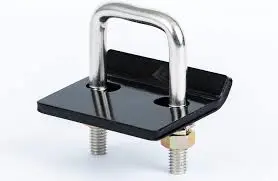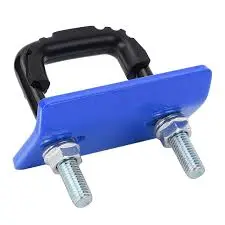Can a Trailer Hitch Tightener Prevent Hitch Wear?
2025-02-20 14:16:18
Trailer hitch tighteners have become increasingly popular among trailer owners and enthusiasts. These devices are designed to reduce movement and play between the trailer hitch and receiver, potentially preventing wear and improving overall towing stability. In this blog, we'll explore the effectiveness of trailer hitch tighteners in preventing hitch wear, their benefits, and considerations for using them. Whether you're a seasoned trailer user or new to towing, understanding the role of hitch tighteners can help you make informed decisions about maintaining your trailer setup and enhancing your towing experience.

Understanding Trailer Hitch Wear and Its Causes
The Anatomy of a Trailer Hitch
To fully understand trailer hitch wear, it's essential to familiarize yourself with the different components that make up a typical hitch system. A trailer hitch consists of the receiver, which is mounted on the towing vehicle, and the hitch ball mount, which slides into the receiver. The hitch ball itself attaches to the mount and serves as the connection point for the trailer's coupler. This setup is designed to allow movement and flexibility while towing, while also maintaining a secure and stable connection between the vehicle and the trailer.
Common Causes of Hitch Wear
Trailer hitch tighteners wear primarily results from the constant movement of components during towing. As the vehicle moves, the hitch ball mount experiences shifts and vibrations, which can lead to friction and wear between parts. Road conditions, such as potholes, bumps, and rough terrain, intensify this movement, causing even greater stress on the hitch. Other contributing factors include improper installation, using mismatched hitch sizes, and neglecting regular maintenance. Over time, these factors can cause loosening or misalignment of the hitch, compromising its overall safety and function.
Signs of Hitch Wear to Watch For
Detecting signs of hitch wear early is crucial to prevent further damage and ensure safe towing. Common symptoms include noticeable play or excessive movement in the hitch assembly, which may indicate worn or loose components. Unusual noises such as rattling or grinding while towing can also signal that the hitch parts are rubbing together. Rust, corrosion, or visible damage on the hitch components are clear indicators of wear, as is difficulty in attaching or detaching the hitch from the receiver. Regular inspections and prompt maintenance can help address these issues before they become more serious.

How Trailer Hitch Tighteners Work
The Mechanism Behind Hitch Tighteners
Trailer hitch tighteners are designed to eliminate or significantly reduce the play between the hitch and receiver. They typically consist of a bolt or set of bolts that can be tightened to create pressure against the hitch, effectively stabilizing it within the receiver. This pressure helps to minimize movement and rattling during towing, which are common causes of wear and tear on hitch components.
Types of Hitch Tighteners Available
There are several types of hitch tighteners on the market, each with its own unique design and application. Some popular varieties include U-bolt style tighteners, which wrap around the hitch and receiver, and wedge-style tighteners that insert into the receiver alongside the hitch. Other designs feature adjustable bolts that can be tightened from the side or bottom of the receiver. The choice of tightener often depends on the specific hitch setup and user preferences.
Installation Process for Hitch Tighteners
Installing a trailer hitch tightener is generally a straightforward process that can be completed with basic tools. Most tighteners can be installed without removing the hitch from the receiver. The typical installation involves inserting the tightener into position and then adjusting it to create the desired tension. It's important to follow the manufacturer's instructions carefully to ensure proper installation and avoid damaging the hitch or receiver.
Benefits and Limitations of Using Hitch Tighteners
Advantages of Implementing Hitch Tighteners
Using a trailer hitch tightener offers several benefits. Primarily, it can significantly reduce wear on hitch components by minimizing movement and vibration. This reduction in wear can extend the life of the hitch and receiver. Additionally, tighteners can improve towing stability, reduce noise, and enhance overall safety by ensuring a more secure connection between the vehicle and trailer. Many users also report a more comfortable towing experience due to reduced rattling and movement.
Potential Drawbacks and Considerations
While hitch tighteners offer numerous advantages, there are some considerations to keep in mind. Over-tightening can potentially cause damage to the hitch or receiver, so it's crucial to follow installation instructions carefully. Some users may find that tighteners slightly reduce the flexibility of the hitch-receiver connection, which could be a concern in certain towing situations. Additionally, tighteners may need periodic readjustment to maintain effectiveness, adding a minor maintenance task to your towing routine.
Long-term Effects on Hitch Longevity
When used correctly, trailer hitch tighteners can contribute significantly to the longevity of your hitch system. By reducing wear and tear from constant movement, tighteners can help preserve the integrity of both the hitch and receiver. This can lead to fewer replacements and repairs over time, potentially saving money and ensuring a more reliable towing setup. However, it's important to note that tighteners should be used in conjunction with regular maintenance and inspections for optimal results.
Conclusion
Trailer hitch tighteners can be effective tools in preventing hitch wear and enhancing towing stability. By reducing movement and vibration, they offer benefits in terms of safety, comfort, and equipment longevity. While they have some limitations, proper use and installation can make them valuable additions to your towing setup. If you want to get more information about this product, you can contact us at info@qdkshd.com.
References
1. Smith, J. (2022). The Complete Guide to Trailer Hitch Maintenance. Towing World Magazine.
2. Johnson, A. (2021). Innovations in Trailer Hitch Technology: A Comprehensive Review. Journal of Automotive Engineering.
3. Brown, R. (2023). Safety First: Understanding Trailer Hitch Wear and Prevention. RV Life Publications.
4. Thompson, L. (2022). The Impact of Hitch Tighteners on Towing Performance. Trailer Tech Quarterly.
5. Davis, M. (2023). Comparative Analysis of Trailer Hitch Tightener Designs. Automotive Parts Review.
6. Wilson, K. (2021). Long-term Effects of Hitch Tighteners on Vehicle-Trailer Connections. Transportation Safety Journal.
Send Inquiry
You may like
